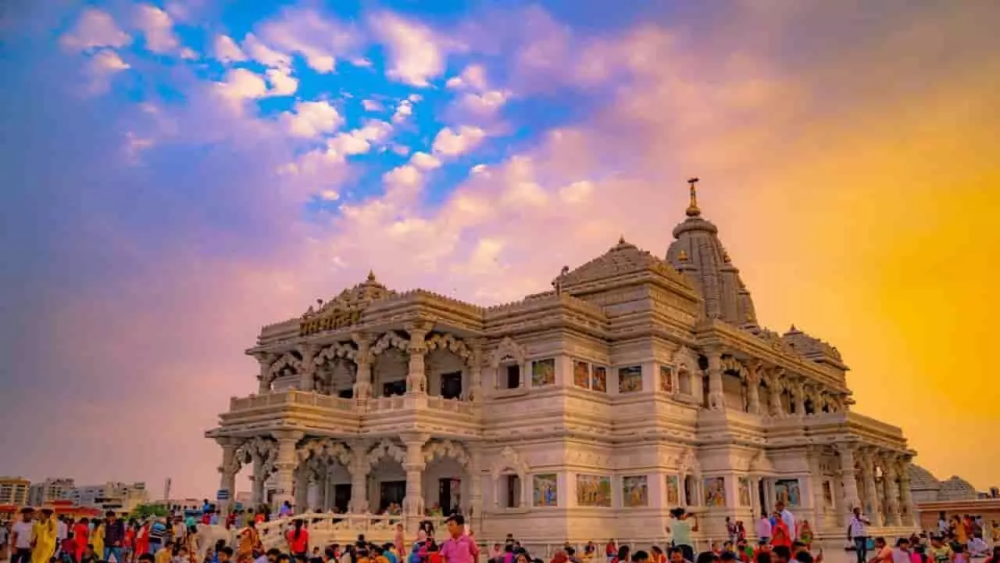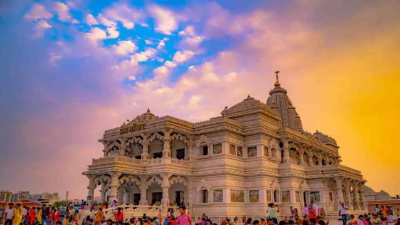

The Sri Krishna Janmasthan Temple is a renowned pilgrimage spot that marks the birthplace of Lord Krishna, one of the most revered gods in Hinduism. The complex is a magnificent blend of spirituality and architectural grandeur. Visitors can explore the various shrines within the complex and participate in the Aarti, a religious ceremony, to soak in the devotional atmosphere. The temple is adorned with intricate carvings and offers a peaceful ambience for meditation and reflection. Pilgrims and tourists alike can learn about the rich history and legends associated with the deity's early life, adding a profound sense of connection to the mythological past of India. The visit usually includes a guided tour to understand the site's significance and to witness the daily rituals performed with great fervor by priests.
Experience tranquility and capture the essence of Mathura by taking a boat ride on the Yamuna River. As you gently row down the river, the boatman regales you with tales of the river's history and its importance in the life of Lord Krishna. The ride provides a unique perspective of the ghats and temples lining the banks. During the early morning or sunset hours, the view of the sun reflecting off the water's surface creates a serene atmosphere. This activity is perfect for photographers and spirituality seekers alike. Many boaters might also allow you to participate in the oar-holding for a more hands-on experience. Boating on the Yamuna is a momentary retreat from the bustling temple activities, offering peace and a chance to reflect upon the intertwining of nature and divinity in Hindu culture.
The Mathura Museum, also known as the Government Museum, is renowned for its extensive collection of artifacts representing the Mathura School of Art. With an impressive assortment of sculptures, coins, pottery, and paintings, the museum offers a deep dive into the region's rich cultural and historical heritage. Visitors can spend hours exploring artifacts that date back to the ancient Maurya and Gupta periods, amongst others. A guided tour provides insight into the Buddhist and Jain relics and the museum's famed terracottas. The museum serves not only as an educational experience but also as a testament to the region's influences over centuries. The museum's calm and well-maintained environment makes it a perfect spot for history buffs and culture enthusiasts to while away their time soaking in the antiquity of Mathura.
Mathura's vibrant bazaars are a bustling hub of activity where visitors can immerse themselves in the local shopping scene. The markets are filled with a variety of goods ranging from religious paraphernalia such as idols and incense sticks to traditional outfits and textiles. Mathura is also famous for its silver ornaments and intricate jewelry. While exploring the bazaars, one can discover and purchase 'Peda', a sweet delicacy native to the city, which serves as a delicious souvenir. Negotiating with the shopkeepers is part of the experience, allowing for interaction with local artisans and vendors. The shopping expedition in Mathura is as much about acquiring unique handcrafted items as it is about experiencing the culture and liveliness of the local economy. It's a great way for tourists to take a piece of Mathura back home with them.
Lathmar Holi is a distinctive form of celebrating the festival of colors, Holi, and is especially popular in Barsana, near Mathura. This unique tradition involves women playfully hitting men with sticks, as the men try to shield themselves. The festival commemorates the playful antics of Lord Krishna and Radha. It is an exhilarating cultural experience filled with vibrant colors, traditional songs, and dances. Attendees are engulfed in a sea of colors as locals and tourists alike participate in the festivities. The energy is infectious, and the festival offers an authentic glimpse into the area's rich cultural tapestry. Visitors can also savor traditional local delicacies that are prepared during the festival. Experiencing Lathmar Holi is a once-in-a-lifetime opportunity to take part in one of the most colorful and jubilant celebrations in India.
The Dwarkadhish Temple, dating back to the year 1814, stands as a pivotal religious site in Mathura dedicated to Lord Krishna. The temple showcases stunning architecture and is known for its elaborate and lively celebrations during major festivals like Janmashtami and Holi. Visitors are treated to a blend of serene spirituality and rich cultural practices as they walk through the temple's impressive gateways and courtyard. Within the temple, beautifully decorated idols captivate devotees and art-lovers alike. The sanctum offers a tranquil space for prayer and worship, and many describe feeling a deep sense of peace upon entering. The temple's priests are known to be welcoming and often share stories and teachings associated with Lord Krishna, enriching the spiritual experience for visitors.
Vishram Ghat, located on the banks of the Yamuna River, holds a special place in the hearts of devotees, as it is said to be the place where Lord Krishna rested after defeating the tyrant Kansa. The evening Aarti ceremony at this sacred spot is a captivating spiritual ritual. Crowds gather to witness the synchronized lighting of lamps and the singing of hymns and prayers. The flickering lights against the evening sky create a mesmerizing reflection on the river, symbolizing the divine presence. The aura during Aarti is charged with devotion, and the air is perfumed with the scent of incense and flowers. Participating in the ceremony or watching from the sidelines promises to be an unforgettable part of any visit to Mathura, offering a chance to connect with the religious traditions of the city.
Kusum Sarovar, a historic sandstone monument of the bygone era, is an impressive structure that stands adjacent to a picturesque water body situated about 25 kilometers from Mathura. The sarovar (pond) is said to have been named after one of the gopis, Kusum, who used to collect flowers here for Lord Krishna. Visitors to the Kusum Sarovar can walk down the steps to touch the cool waters or sit for a moment of introspection. The cenotaphs around the pond honor the memory of members of the royal Bharatpur family. The intricate carvings and immaculate architectural design make this spot a photographer's delight. During the visit, tourists often get to interact with locals and share a glimpse of their daily life as they also come to the pond for various rituals or for a refreshing swim.
The Govind Deo Temple in Mathura is a testament to the architectural excellence of ancient India and its veneration for the beloved god, Lord Krishna. Built in 1590 by General Man Singh of Amber, this temple is a fine example of Indian temple architecture with elements of Western, Hindu, and Muslim designs. The grand structure was erected at the exact spot where Lord Krishna is said to have revealed himself to the world. As visitors stroll through its halls, they can marvel at the detailed stone carvings and can find a serene space for prayer and contemplation. Despite the ravages of time and historical invasions that the temple has endured, it continues to stand as a significant symbol of the transcendental heritage of Mathura.
Embark on a culinary journey through the bustling streets of Mathura to savor the local cuisine, which is deeply intertwined with the city's religious and cultural identity. Famous for its dairy products, Mathura offers an array of sweets and savories made from milk and ghee like pedas, lassis, and kachoris. A guided food tour introduces food lovers to the best local eateries and street food vendors, providing an immersive gastronomic experience. The tour not only allows you to taste the delectable local cuisine but also offers insights into the preparation methods and the stories behind the popular dishes. With an array of flavors ranging from spicy and savory to sweet and rich, a Mathura food tour is a treat for any epicurean traveler.
